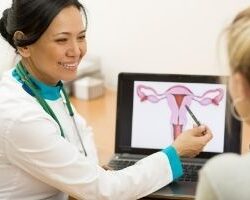
Getting pregnant is all about timing. If you schedule intercourse when the conditions are right for egg and sperm to meet, your chances for fertility are escalated. So, in order to find out when you are the most fertile, you must first determine when you are ovulating. Your most fertile days are the six days leading up to and including ovulation. These six days are referred to as the “fertile window” of a woman’s cycle and reflect the lifespan of sperm (5 days) and the lifespan of the ovum (24 hours). The key to conception is having sex during that small window of time, when the ripened egg is released from one of the ovaries and moves into the fallopian tube.
So how do you determine when you are ovulating? The best way is to use an ovulation calendar to mark the length and regularity of your menstrual cycle. An average menstrual cycle is 28 days long, however some cycles range from 23 to 35 days in length and vary in length each month. Since ovulation will occur two weeks before your menstrual cycle starts, charting your menstrual cycle is your best bet to see your particular pattern. For example, if you determine your average menstrual cycle is 28 days, you should ovulate around day 14. Your maximum chance for pregnancy will be in the three days leading up to and including ovulation. On these three days, you will have a 27-33% chance of becoming pregnant.
Other ways to pay attention to the signs that your body is ready to ovulate are by checking your basal body temperature or cervical mucus and by using a ovulation kit.
Basal Body Temperature
One sign that ovulation has occurred is when your regular body temperature or basal body temperature (BBT) increases slightly. You can detect this thermal shift by taking your temperature every morning at the same time before you get out of bed with a basal thermometer.
If you record your temperature every day, you will be able to detect when one of your ovaries has released an egg. For most women, temperature increases about a half a degree 24 to 48 hours after ovulation. You are most likely to get pregnant 2 or 3 days before ovulation and 12 to 24 hours after. After your temperature has spiked for 3 days, your chances of conceiving drop.
Post ovulation, your temperature will begin to rise slightly, sometimes by less than a degree, and it will stay higher until menstrual cycle begins again.
How to check your cervical mucus:
The same hormones that control your menstrual cycle also affect your cervical mucus. As your ovaries prepare to release an egg, your cervix makes more mucus. A few days before ovulation, it may be sticky and cloudy or whitish. Then, right before you ovulate, the mucus gets slippery, like egg whites. This stage usually lasts 3 or 4 days, the time frame of when you are most likely to get pregnant. After ovulation, when your fertile days are past, the mucus usually becomes thicker, then it will gradually dry up.
Ovulation predictor kits
Although using an ovulation predictor kit to determine ovulation will be more expensive than tracking your temperature, it may be more accurate. Available in drugstores, an ovulation predictor kit measures the level of luteinizing hormone (LH) in your urine. By testing your urine with tester strips, you can find out when LH levels are rising, a sign that one of your ovaries is about to release an egg.
So what if you don’t get pregnant?
Even if you learn the signs of ovulation and schedule intercourse during your most fertile days, remember on average, it takes six to eight months to conceive, and that, in any given month, you probably have a 15 to 20 percent chance of getting pregnant. If you’re under 35 and have had properly timed intercourse for 12 months, or 35 or older and have been trying for six months, then it’s time to see one of our specialist at The Fertility Institute for a fertility evaluation.



